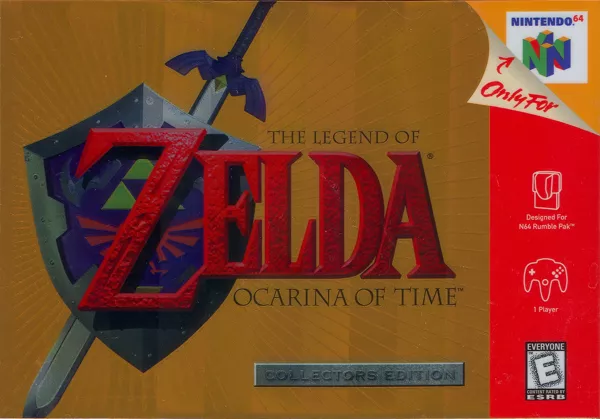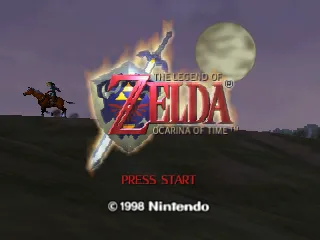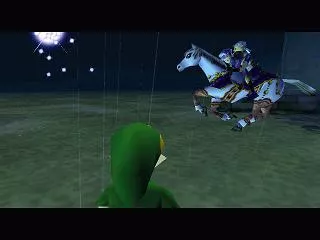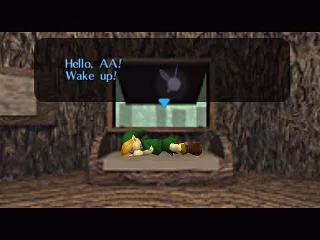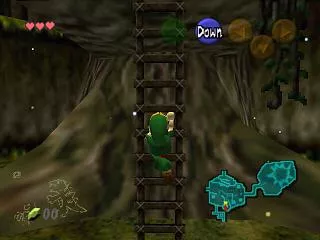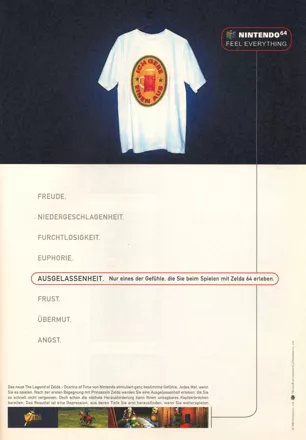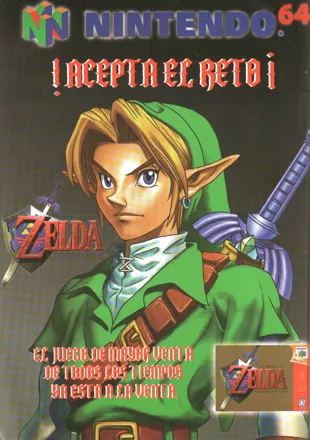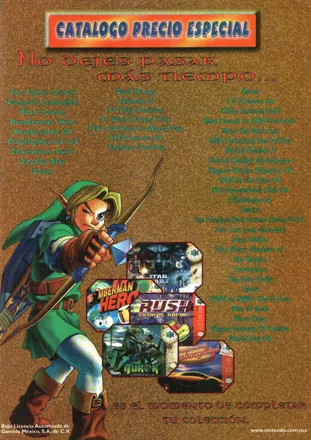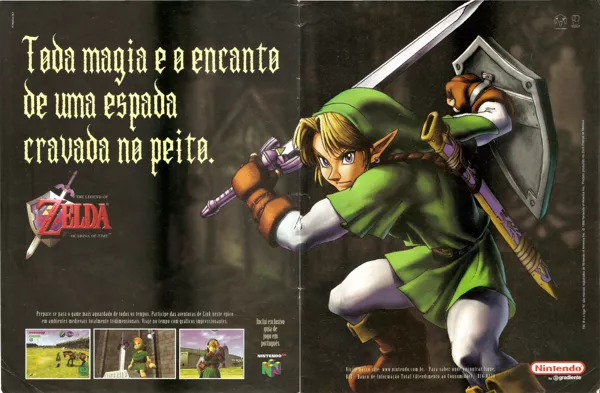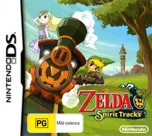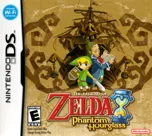The Legend of Zelda: Ocarina of Time
Description official descriptions
A young boy named Link was raised in the village of the elf-like Kokiri people. One day a fairy named Navi introduces him to the village's guardian, the Great Deku Tree. It appears that a mysterious man has cursed the tree, and Link is sent to the Hyrule Castle to find out more. Princess Zelda tells Link that Ganondorf, the leader of the Gerudo tribe, seeks to obtain the Triforce, a holy relic that grants immense power to the one who possesses it. Link must do everything in his power to obtain the Triforce before Ganondorf does, and save Hyrule.
Ocarina of Time is the first 3D installment of the Legend of Zelda series. Like most of its predecessors, it is an action game with puzzle-solving and light role-playing elements. Gameplay is similar to the previous games, allowing Link to explore the world and complete dungeons to obtain key items and advance the plot. Sword combat as well as many familiar items such as boomerang, bombs, the series' currency (rupees) of various values, heart containers, and their collectible fragments permanently increasing Link's health, etc., return in this installment. Link can now lock on enemies for melee and ranged combat, actively use a shield to deflect projectiles, as well as use various magic items. Dungeon exploration is somewhat more puzzle-oriented than in earlier games. Link can climb certain surfaces, dive underwater, as well as automatically jump.
The game begins with the player controlling the child Link, but later on, an adult Link becomes a playable character as well. Each of them has certain unique abilities: for example, only adult Link can use a bow and arrows, but only the child Link can crawl through narrow spaces. During the course of the game, the player obtains the Ocarina of Time. Learning and playing melodies on that ocarina is needed to advance the plot, complete certain side quests, or travel in time, switching between the two versions of Link. It is also possible to befriend and ride a horse named Epona to facilitate travel between areas.
Spellings
- ゼルダの伝説 時のオカリナ - Japanese spelling
Groups +
- Console Generation Exclusives: Nintendo 64
- Game Center CX challenge games
- Gameplay feature: Aging
- Gameplay feature: Auto-mapping
- Gameplay feature: Day / night cycle
- Gameplay feature: Drowning
- Gameplay feature: Equipment quick slots
- Gameplay feature: Fishing
- Gameplay feature: Horse riding
- Games made into books
- Games referenced in movies
- Legend of Zelda series
- Nintendo Player's Choice releases
- Protagonist: Elf
- Setting: Inside a giant creature
- Theme: Time travel
Screenshots
Promos
Videos
See any errors or missing info for this game?
You can submit a correction, contribute trivia, add to a game group, add a related site or alternate title.
Credits (Nintendo 64 version)
76 People (66 developers, 10 thanks) · View all
| Executive Producer | |
| Producer | |
| Director | |
| Program Director | |
| Chief Programmer | |
| Main Program | |
| [ full credits ] | |
Reviews
Critics
Average score: 97% (based on 81 ratings)
Players
Average score: 4.2 out of 5 (based on 429 ratings with 17 reviews)
Possibly the Best Game of ALL Time!
The Good
Altough it's been a while since the initial release, I'm gonna say a few words about this beacon of light anyway. "Ocarina of Time", as the first true 3D-game in the serious, stands out even now as maybe the very best game of all times in my book. Even today I instantly say "Zelda to the 64" when people ask what the best game I've ever played was.
The weeks it took me to complete this game was ABSOLUTE pure magic. I was literally lost in front of the screen from the opening credits and to the final fight with Gannondorf. When the end-sequence slowly faded away fon my screen - and the game was over - I almost started crying. This is a masterpiece through and through, nothing less. I guess it's the friendly gameplay that cought me, as well as the (then) beautiful graphics and polished mechanics. The puzzles got harder and harder, the story more and more intense - and the areas you explored got more and more interesting. I wasn't bored for a second ... a true gem from Nintendo this.
The Bad
I actually thought hard about something negative to say, but I honestly can't think of anything. It would have been fun with a larger selection of armor, gadgets and weapons - but I didnt really miss it at the time, which means the ones I got was enough to keep me happy. Not really anything else to say ...
The Bottom Line
I've been a gamer since ... well, as long as there have been games to play - and I can honestly say this game stands out, even today, as the best game I have ever played. (Rivaled by World of Warcraft and The Curse of Monkey Island)
Nintendo 64 · by SkyMarshall (3) · 2006
The 2D to 3D transition was a huge success.
The Good
Zelda: Ocarina of Time, gives you your money's worth. There are endless side-quests to complete, such as destroying the "Gold Skulltulas", collecting the heart-pieces, and completing the trading process.
The Bad
There isn't really anything bad about Zelda: Ocarina of Time. It has been as much of a success as its predecessors.
The Bottom Line
Zelda: Ocarina of Time is aimed for all ages, all though it is a little juvenile at times. A must-have game for RPG lovers and Zelda fans.
Nintendo 64 · by What Whut (1) · 2001
The Zelda Game You Knew Was Coming, But Only After A Long Wait
The Good
Why So Serious?
Released in 1998, and almost too late to the N64 party, Zelda 64, was the 3D Zelda adventure we all knew was coming. What we did not know was it would take half a decade before it would be released. Due to many false starts and silly ideas.(Remember the ill fated N64 Disk Drive?-MM-)
I would like to make special mention of my take on Zelda. Some Moby Gamers seem to be under the impression that I dislike the Zelda series, this simply is not true. While I am far from a hardcore fan of the series, there are several games in the series that I actually enjoyed. Such as: Zelda II,( A cruelly underrated adventure.-MM-) and Zelda: Link’s Awakening, among others.
Some overzealous Zelda fans and Nintendophiles, have even accused me of being a “hater” of the series. One such case occurred here on Moby. Some deluded fan boy, actually had the testicular fortitude, to send me a private message, declaring that I was a stupid head, or some such silly thing, for just expressing my honest opinion, about a particular Zelda game.
How did I respond you ask? Well, as any borderline psychotic might, I laughed at the poorly written and conceived attempt, to change my mind on the matter. And then I sent the dingus, a harshly worded response. And no, I never heard back from the belligerent fan boy.
Now I know what you are thinking. What in the nine bloody hells does any of this have to do with my review? Well, the short answer is, that without calling attention to the fan boy, I hereby dedicate this review to you. In the words of Pink Floyd: “Shine on you crazy diamond.”
And I was going for the longest intro to a review in Moby history record.(Did I win, if so what did I win? Cash?-MM-) Or does Jazz Oleg, Lasttoblame, or Classic Nigel, still hold the honor? Without further ado, here is my review for Zelda 64: The Ocarina Of Time.
Of Elves And Swords….
Zelda 64, begins like many fantasy yarns, with the advent of the hero. We find Link, a pint sized elf lad, living in the forests of the Kokiri. Link as it turns out is the joke of the nationhood, yet he cares not for he is feeling good. And one particular morning he makes a new friend. A little pixie, Navi who is not unlike, Landstalker’s Friday.(Only unlike Friday, she is very annoying.-MM-)
She tells Link, of what he must do. His first task is to help the magic tree, of his village.(All fantasy worlds have talking trees, don’t you know?-MM-) And then for the first time in his young life leave behind the only home his has every known.
For here his quest gets more and more complex. And without giving too much away, I will say that out of all the Zelda games that I have played this one has one of the better stories. And it is the little things that make it worth you time. Link is an outcast in his own home. Yet once he leaves his home he will make new friends, and he is the only one that can save Hyrule. This is also by far one of the most realized Zelda incarnations. And he will find that some things are worth fighting for. Or perhaps he just wants to bang Zelda?
What is a great story with out gameplay? The answer is most likely not a videogame. I can say however that the gameplay in Zelda 64 is actually well done. And fun to play. The huge difference is that the game is now 3D not 2D. But that makes more if a difference than you might think.
The dungeons, combat, and just about everything else have been overhauled for the new engine, For the most part it works for the better. With a few exceptions. More on that later, now I would like to talk about the ways that it works better.
The dungeons are much larger and involving than they were in the 2D days. And as it turns out this is both a good and a bad thing. The good includes that it makes the dungeons more difficult. But not unfairly so. Not that all 2D games had easy dungeons, any one who has played, Phantasy Star II, Zelda II, or The Immortal, can attest to that. But they are more complex and often fun in Zelda 64.
The bigger dungeons also mean bigger boss fights. In cool retro fashion some of the classic bosses make an appearance here.(In many ways this game is a retelling of the original.-MM-) Fighting the dragon, and Gannon, in particular is pretty damn sweet.
Speaking of the combat. I think that you will find that the combat system is Zelda 64, is far better and more refined and quite frankly more fun. You can slash, hack, and thrust your way to victory. And now you can even lock-on to a target. And this is very effective. Unlike some games. Link, can also perform special moves, downward slashes, and leaping stabs among others. Great stuff.
And Link, has other weapons at his disposal. As a child, he can use a sling-shot. And as an adult he can use a long-bow. And did I mention he can shoot some punk ass monsters while on horse back? And did I mention that Link can now ride a horse? I pretty sure I did, yes definitely.
“In the country side I wander far and wide….”
The exploration is also improved because, of the new engine. I actually had more fun traveling and exploring Hyrule in 3D than I ever did in 2D. This is due to a few things. First off, in the old Zelda games of the 2D persuasion, if you saw a heart container, some where in the world it was fairly easy to figure out who to obtain it. In Zelda 64, due largely to the use of a 3D engine, it can be much more challenging, to obtain the hidden life-ups. And I enjoy a good stiff challenge.
In addition, to exploring of foot. Link, can now ride a horse. This not only makes travel faster, but it also allows you to deliver death from the saddle, via your long bow. Unfortunately, you cannot use you sword from the saddle. The horse, also allows you to partake in a racing mini game. If you are into that kind of thing.
As per Zelda tradition, there are tons on mini games, and side quests to undertake. And a great deal of secrets to uncover. Overall, they are a nice diversion, from the main quest.
Hyrule is big….that is for a game from 1998. On a console. Compared to Fallout 3, Oblivion, and even Gothic II, it is pretty damn small. So keep this in mind. That means you nintendophiles.
The graphics are good, for the time and for the N64. As at the time it had the most raw power of any console…until the Dreamcast anyhow. There is very little pop-up. Which plagued PSX and Saturn games, and the game looks pretty crisp and colorful. But not to colorful, like some other Zelda games.
For MIDI music, a device first devised in the 1980’s the score in Zelda is decent, that is to say it gets the job done, but is a far cry from one of personal favorites. But I am sure that others will disagree, and that’s all well and good. The sound effects on the other hand, well you will have to see the “bad” section for that.
I would also like to make a mention of the controls in Zelda 64. As they are very well designed. And work almost perfectly. The only downside would be that you would have to play this on an N64, on an emulator, it plays like crap, unless you hook your N64 controller to your PC, which can be done. But that is neither here nor there. Hell, the controls are so well plotted that a similar control scheme was used in Shenmue 1 and 2.(You know the boss, but criminally underrated Dreamcast games?-MM-) And it was also effective in those aforementioned games.
The Bad
Accusations And Ruminations….
Even as I write this, I realize, full well, that some Nintendo fans, will curse me and burn effigies dedicated to me. But I will speak my peace anyhow. I think that Link, is one of the lamest heroes ever. There I said it. And I know what the opposition will argue, ’He is supposed to be the pure eternal hero.’ But to that I say that is why he fails, he is too boring. He lacks the complexity of Landstalker’s hero Nigel. Or the dark decadence of Kain, from the Blood Omen, games. And those are just two better protagonists from other action RPGS, let alone films or books.
He also has zero personality. I also realize full well, that this is intentional, but it still is stupid. In Gothic you ARE the nameless hero, but at least he actually has a personality, he is not just an automaton.
The sound effects are to but it mildly annoying as hell. From the cacophony, of Navi’s, “Hey lissssten!”. To the once and former annoyance of the sirens warning that your health is low, like I can’t bloody see that. And how could I forget Link’s piercing cries of HUH! WAAH!, etc. It is like listing to nails being dragged across, a blackboard.
I am having trouble putting into words how annoying Navi is. And it is so unnecessary. I understand that Nintendo, wanted to help the gamer, remember what they were supposed to be doing, but why does she have to wail like a bloody banshee, every 30 seconds? When all they had to do was to take a page from Phantasy Star IV, and let the gamer “talk” to Navi via the in game menu.
Hyrule’s sheer size is also a huge disadvantage. In some ways. For starters Hyrule seems dead. There is hardly a soul around anywhere. Except monsters and Link. And some of the monsters have a silly designs, not unlike the B-Film, “The Creeping Terror“. At least getting lost is almost impossible.
This game is so long, that there is little chance of second play. At least for me. Especially since I did all the extra stuff the first time. It may also be to easy for some people tastes.
Some complain, that Zelda 64, is childish. And while I can see there point, I have to disagree. It has some adult theme’s they are just often obscured, by silly situations. In many ways this is one of the most mature Zelda games.(Aside from Zelda II.-MM-) And many Zelda fanatics, themselves tend to misunderstand there own favorite game series, I won’t into why here as it pertains to a spoiler. I can tell you that some reviews for this game I have read and even a few on Moby, clearly do not understand some of the plot devices. Perhaps there own perceptions and or biases have colored there perceptions?
The Bottom Line
This may be the silliest review I have every written, shall I end it?
When all is said and done, Zelda 64 is a fun game. But not without it’s flaws. I would recommend it to others. If they can put there predeterminations aside. And yes this applies to both camps. Those that love Zelda and Nintendo, and those that wrongly accuse it of being childish.
Nintendo 64 · by MasterMegid (723) · 2009
Discussion
| Subject | By | Date |
|---|---|---|
| Am I the only one? | GAMEBOY COLOR! (1990) | Jul 15, 2012 |
| Beta screenshots ? | GAMEBOY COLOR! (1990) | Jun 13, 2009 |
Trivia
1001 Video Games
The N64 version of The Legend of Zelda: Ocarina of Time appears in the book 1001 Video Games You Must Play Before You Die by General Editor Tony Mott.
Development
The Legend of Zelda: Ocarina of Time started life in development for Nintendo's 64DD add-on for the Nintendo 64 (which was a disk drive that was only released in Japan with little fanfare). The 64DD flopped in Japan and it wasn't even released in the USA. As a result, this game, instead of being released in disks, was crammed into a cartridge (which was the biggest N64 pre-Expansion Pak cartridge released, in terms of space). Even though it was originally developed and planned for the 64DD, it was announced to much surprise that Zelda would release in cartridge form for the N64 first; further indicating that the disk drive platform was not gaining the traction Nintendo had hoped for.
Cartridge
Due to overwhelming fan requests, Nintendo decided to release the original production releases of the game as a gold-colored cartridge, restoring the 'golden cartridge' lineage that had previously been broken by the SNES version of The Legend of Zelda: A Link to the Past, and The Legend of Zelda: Link's Awakening for Game Boy.
Versions
There are at least three different versions of the game: 1.0, 1.1 and 1.2. The golden (limited edition) carts, as well as some gray carts, are all 1.0. The majority of the ordinary gray carts are 1.1, and many of the later produced ones are 1.2.
The only notable change between 1.0 and 1.1 is that the Fire Temple music was changed a little bit. It had a chant from an Islamic prayer looped in the background which offended some members of the Islamic community. 1.1 also fixed some bugs, the most famous of them being the sword-losing bug. In 1.0, if the player saves the game in the end battle after losing the Master Sword, and restart the game, they don't have the sword anymore, but they can use all items while riding Epona. Also the final boss originally had red blood which was changed to green in a later version.
Fan remake
Daniel Barras was making a PC fan remake of the game, titled Ocarina of Time 2D. Basically, this was to be a remake with all of the story, areas, creatures and items from The Legend of Zelda: Ocarina of Time, using graphics similar to The Legend of Zelda: A Link to the Past. Regrettably, Nintendo was not very happy about this (or any other Zelda remakes that use The Legend of Zelda: A Link to the Past sprite rips), so the project is gone now.
Stone of Agony
The Stone of Agony allows players to feel a rumble to find hidden areas. This of course only works if they have a rumble pack accessory attached to their N64 controller (or are playing the Gamecube version). For the Wii Virtual Console version, this feature has been disabled.
Left-handedness
Link has always been left-handed, but it is particularly noticeable starting with this game. In the original title, this wasn't always noticeable due to sprite-flipping techniques. The reason for Link's left-handedness is that his creator, Shigeru Miyamoto, is also left-handed.
Voice acting
Voice acting for the adult Link was done by Nobuyuki Hiyama, who also did the voice acting for Link in Super Smash Bros. The person who did the voice of Link as a child, Fujiko Takimoto is a woman. This explains Link's extremely high voice.
Ad controversy
An advertisement for Ocarina of Time shown in British TV proved to be controversial. Using the slogan "Willst thou get the girl? Or play like one?", the ad provoked complaints to the Independent Television Commission from viewers who considered it sexist. ITC however ruled against taking the ad off the air, stating that "such tongue-in-cheek treatments were unlikely to have the widespread negative affect that those who complained feared."
References: Zelda series
- Many of the character names, such as Rauru, Mido, Ruto, Saria, and Darunia, are actually names of towns in
Zelda II: The Adventure of Link . - The characters Malon and Talon are based on Marin and Tarin from The Legend of Zelda: Link's Awakening. Marin was a Zelda lookalike who also had a beautiful singing voice.Tarin was her father and had a liking for mushrooms (he resembled Mario).
References
- Both Talon and his assistant Ingo resemble Mario and Luigi, although it's interesting to note that they have an antagonistic relationship. Both Talon and Malon wear medallions that are shaped like Bowser's head.
- Looking through the windows of Zelda's Castle, players can see pictures of Mario, Bowser and other
Super Mario Bros. characters adorning the walls. - When using a GameShark, the player can make Arwings appear that will attack Link. The Arwing is the primary spacecraft of the
Star Fox series . - The horse in the game is named after the Celtic horse goddess, Epona.
- The lantern-carrying ghosts called Poes are named after the famous horror writer
Edgar Allan Poe . - In the Forest Temple the player encounters the four Poe sisters: Joelle, Beth, Amy, and Meg. They are named after the four protagonists of the novel Little Women by
Louisa May Alcott .
Awards
- EGM
- February 2006 (Issue #200) - #8 out of 200 of the "Greatest Games of Their Time" list
- Game Informer
- August 2001 (Issue #100) - #11 on the "Top 100 Games of All Time" poll
- GameSpy
- 2001 – #43 Top Game of All Time
- Nintendo Power
- Issues #196-200 - #1 "Top 200 Nintendo Console Games of All Time"
- Retro Gamer
- October 2004 (Issue #9) – #5 Best Game Of All Time (Readers' Vote)
- WatchMojo
- August 2014 - ranked #1 in the Top 10 Video Games of All Time
- The Strong National Museum of Play
- 2022 – Introduced into the World Video Game Hall of Fame
Information also contributed by Andrew Shepard, Attila, Big John WV, festershinetop, Guy Chapman, Mark Ennis, Matt Neuteboom, ModestMr.Green, Tiago Jacques, WildKard, and WWWWolf.
Analytics
Upgrade to MobyPro to view research rankings!
Related Sites +
-
OC ReMix Game Profile
Fan remixes of music from The Legend of Zelda: Ocarina of Time. -
The Legend of Zelda: Ocarina of Time/Master Quest
Nintendo of America's official web site for the GameCube version. -
Zelda 64 Fan Site
A fan site dedicated to the Nintendo 64 Legend of Zelda -
Zeldapower.com Forums
Message Boards for all of the Zelda games
Identifiers +
Contribute
Are you familiar with this game? Help document and preserve this entry in video game history! If your contribution is approved, you will earn points and be credited as a contributor.
Contributors to this Entry
Game added by Kartanym.
Wii U added by Michael Cassidy. Nintendo Switch added by Rik Hideto. Wii added by Sciere.
Additional contributors: PCGamer77, Jeanne, Joshua J. Slone, gamewarrior, Havoc Crow, BobaMa, Cantillon, Arejarn, Patrick Bregger, Thomas Thompson, FatherJack, John H., WONDERなパン, SoMuchChaotix.
Game added April 3, 2001. Last modified March 11, 2024.
